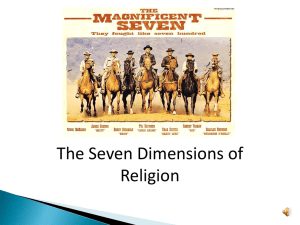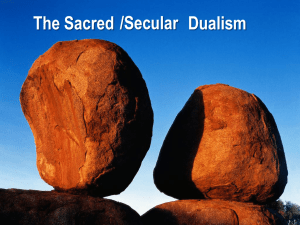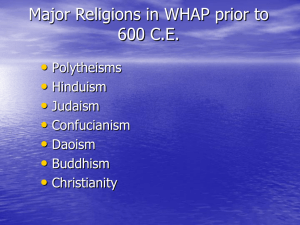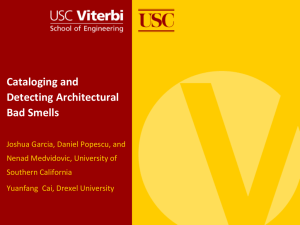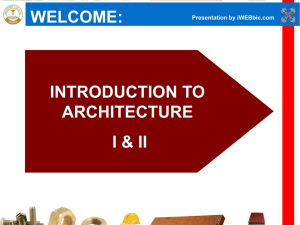Hermeneutics of Sacred Architecture - Hi
advertisement
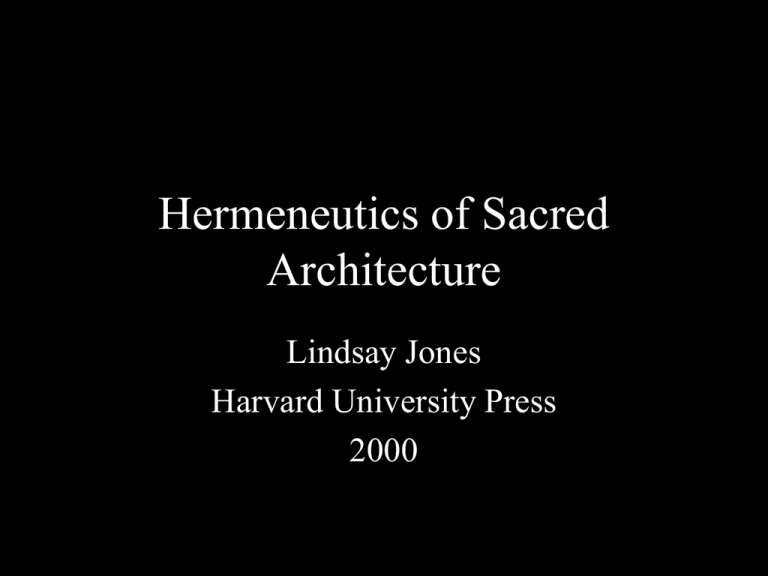
Hermeneutics of Sacred Architecture Lindsay Jones Harvard University Press 2000 A. Architecture as Orientation • 1. Homology: Sacred architecture that presents a miniaturized replica of the universe and/or conforms to a celestial archetype. • 2. Convention: Sacred architecture that conforms to standardized rules and/or prestigious mythicohistoric precedents • 3. Astronomy: Sacred architecture that is aligned or referenced with respect to celestial bodies or phenomena A. 1. Homology • Architectural expressions of hierophany or an earthly manifestation of “the sacred”. • Architectural imitations of celestial precedents or “archetypes”. • Architectural expressions of imago mundi, or cosmographic ordering. • Architectural expressions of axis mundi, or the symbolism of the center. A. 2. Convention • Architectures that conform to universalistic principles and proportions that are (considered to have been) derived from largely empirical observations of the natural world. • Architectures that conform to axoimatic stipulations that are (considered to have been) delivered by divine revelation or decree. • Architectures that conform to precedents that are (considered to have been) established by prestigious historical and/or mythical presence. A. 3. Astronomy • Astroarchitectural references, when coordinated with other orientational strategies, can substantially enhance the appearance of harmony and conformity to a generalized world order, and thus enhance the legitimacy – and allure – associated with a specific ritual-architectural circumstance. • Ritual-architectural choreographers may, on occasion, find ways to capitalize on some predictable sky phenomenon as a means for strategic scheduling of a ceremony. • Astroarchitectural orientations – which work, in a sense, to incorporate sky phenomena into the ritual context – can likewise substantially enhance the presentation and apprehension of meanings that bear on each of four commemorative elements: – – – – Commemorations of Divinity Commemorations of Sacred History Commemorations of Sociopolitical Concerns Commemorations of the Dead B. Architecture as Commemoration • 1. Divinity: Sacred architecture that commemorates, houses, and/or represents a deity, divine presence, or conception of ultimate reality. • 2. Sacred History: Sacred architecture that commemorates an important mythical, mythicohistorical, or miraculous episode or circumstance. • 3. Politics: Sacred architecture that commemorates, legitimates, or challenges socioeconomic hierarchy and/or temporal authority. • 4. The Dead: Sacred architecture that commemorates revered ancestors and/or other deceased individuals or groups. B. 1. Commemoration of Divinity • Personification or divinization of natural “architectural” features of the landscape. • Architecture that is conceived as the actual body of a deity. • Architecture that is conceived as an abode, residence, or house of a deity or divine presence. • Architecture that is conceived as a built expression of the attributes of a divinity. B. 2. Commemoration of Sacred History • Architectural configurations that serve as the stage-setting or backdrop for the reenactment of notable mythic, historic, and/or miraculous episodes. • Ritual-architectural commemorations of cosmogony. • Ritual-architectural commemorations of mythicohistorical episodes or occurences. • Ritual-architectural commemorations of mythicohistorical individuals or personages. • Ritual-architectural commemorations of mythical places, sites or locations. B. 3. Commemoration of Politics • Ritual-architectural configurations that reflect and perpetuate the prevailing social hierarchy. • Ritual-architectural configurations that challenge, undermine, and (maybe) change the prevailing social hierarchy. • Ritual-architectural configurations that serve more explicitly governmental functions. B. 4. Commemoration of the Dead • Architectural configurations that facilitate “bodiless memorializing”. • Architectural configurations that serve as the actual embodiment, reactualization, or transmutation of the dead. • Architectural configurations designed for the assiduous treatment and accommodation of the physical, bodily remains of the (un)dead. C. Architecture as Ritual Context • 1. Theater: Sacred architecture that provides a stage setting or backdrop for ritual performance. • 2. Contemplation: Sacred architecture that serves as a prop or focus for meditation or devotion. • 3. Propitiation: Sacred architecture and processes of construction designed to please, appease, and/or manipulate “the sacred” (however variously conceived). • 4. Sanctuary: Sacred architecture that provides a refuge of purity, sacrality, or perfection C. 1. Theater • Theatric allurement may entail the presentation of dramatic architectural spaces that seduce, affect, or amaze a solitary individual. The more prominent instances of theatric allurement involve carefully scheduled interactions between ritual performers and an audience of onlookers. • Dramatic presentational means intensify the effect and/or affect – that is, enhance the “quality of knowledge” – of the information presented in those contexts. C. 2. Contemplation • Ritual-architectural instigation via contemplative modes involves the presentation of architectural configurations and elements that can serve as supports, guides, or perhaps “maps” to some sort of devotional experience. • Contemplative modes may serve to express messages with respect to each of the four commemorative elements but in each case the pertinent messages may be: – Highly rarified, cerebral, and abstract – More plainly educative and even didactic C. 3. Propitiation • Propitiatory ritual uses of standing (already-built) architecture. • Architectural construction (or destruction) processes that are themselves conceived as propitiatory ritual: – (Re)building for periodic renewal – Building as a demonstration of devotion, sacrifice, or offering – Building as investment or petition – Ritualized destruction and defacement (“unbuilding”) C. 4. Sanctuary • Requisite preparation of various elements of the ritual-architectural situation: – Appropriation of natural “sanctuaries” – Preparatory sanctification of apparently ordinary places or human constructions – Preparatory sanctification of human ritual actors • Sanctuary modes may work with each of the four commemorative factors (divinity / sacred history / politics / the dead)

